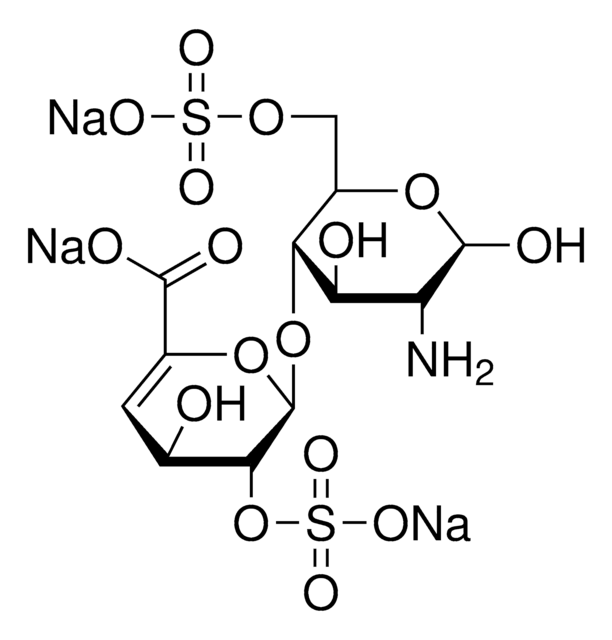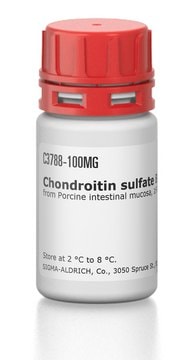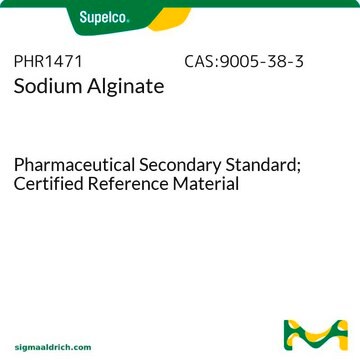H6512
Heparinase II from Flavobacterium heparinum
Lyophilized powder stabilized with approx. 25% bovine serum albumin, lyophilized powder, ≥100 units/mg protein (enzyme + BSA)
Synonym(s):
Heparin lyase II
Sign Into View Organizational & Contract Pricing
All Photos(1)
About This Item
Recommended Products
biological source
bacterial (Flavobacterium heparinum)
Quality Level
conjugate
conjugate (Glucosaminoglycan)
form
lyophilized powder
specific activity
≥100 units/mg protein (enzyme + BSA)
mol wt
84.1 kDa
storage temp.
−20°C
General description
Heparinase II is one of three key heparin-degrading enzymes of Flavobacterium heparinum (also known as Pedobacter heparinus1). It belongs to the polysaccharide lyases family PL21.
Application
Heparinase II from Flavobacterium heparinum has been used:
- for digestion of heparin sulfate during exosome isolation
- for digestion of heparin sulfate in notochordal cell conditioned media (NCCM) to investigate the content of glycosaminoglycans in NCCM
- as a component of digestion buffer during cell surface glycan processing
- as a component of heparin lyase (HSase) mix to remove the heparin sulfate on the 293ͰT/ACE2 cell surface and study the effect of histones on the infectivity of pseudovirus
Biochem/physiol Actions
Heparinase II cleaves heparan sulfate, and to a lesser extent heparin (relative activity about 2:1), at the α (1-4) linkages between hexosamines and uronic acid residues (both glucuronic and iduronic), yielding mainly disaccharides. Heparinase II has the broadest substrate specificity of the three heparinases Heparinase enzymes helps in decoding the complex structures of substrates. Heparin interferes with DNA transcription in PCR and in reverse transcription of RNA. Heparinase II has been used to remove heparin for downstream analysis of genomic DNA.
Unit Definition
One unit will form 0.1 μmole of unsaturated uronic acid per hr at pH 7.0 at 25 °C. One International Unit (I.U.) is equivalent to approx. 600 Sigma units.
Other Notes
View more information on enzymes for complex carbohydrate analysis at www.sigma-aldrich.com/enzymeexplorer
Storage Class Code
11 - Combustible Solids
WGK
WGK 3
Flash Point(F)
Not applicable
Flash Point(C)
Not applicable
Personal Protective Equipment
dust mask type N95 (US), Eyeshields, Gloves
Certificates of Analysis (COA)
Search for Certificates of Analysis (COA) by entering the products Lot/Batch Number. Lot and Batch Numbers can be found on a product’s label following the words ‘Lot’ or ‘Batch’.
Already Own This Product?
Find documentation for the products that you have recently purchased in the Document Library.
Customers Also Viewed
David Shaya et al.
The Journal of biological chemistry, 285(26), 20051-20061 (2010-04-21)
Heparinase II (HepII) is an 85-kDa dimeric enzyme that depolymerizes both heparin and heparan sulfate glycosaminoglycans through a beta-elimination mechanism. Recently, we determined the crystal structure of HepII from Pedobacter heparinus (previously known as Flavobacterium heparinum) in complex with a
McLean, M.W., et al.
Proc. 8th Int. Symp. Glycoconjugates, 1, 73-73 (1985)
PCR-sequence-specific primer typing of HLA class I and class II alleles.
Mike Bunce
Methods in molecular biology (Clifton, N.J.), 210, 143-171 (2002-11-05)
Moffat, C.F., et al.
Proc. 8th Int. Symp. Glycoconjugates, 1, 79-79 (1985)
R S Heyderman et al.
Methods in molecular medicine, 67, 649-661 (2001-01-01)
The vascular endothelium forms an essential barrier against invasion by Neisseria meningitidis from the nasopharynx into the circulation and against meningococcal invasion from the bloodstream into the brain. In previous chapters, there has therefore been considerable emphasis on techniques designed
Our team of scientists has experience in all areas of research including Life Science, Material Science, Chemical Synthesis, Chromatography, Analytical and many others.
Contact Technical Service













